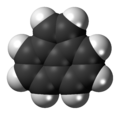Acenaphthylene
Appearance
| |||
| Names | |||
|---|---|---|---|
| IUPAC name
Acenaphthylene
| |||
| Systematic IUPAC name
Tricyclo[6.3.1.04,12]dodeca-1(12),2,4,6,8,10-hexaene | |||
| Other names
Cycopenta[de]naphthalene, Acenaphthalene
| |||
| Identifiers | |||
3D model (JSmol)
|
|||
| ChEBI | |||
| ChemSpider | |||
| ECHA InfoCard | 100.005.380 | ||
PubChem CID
|
|||
| UNII | |||
CompTox Dashboard (EPA)
|
|||
| |||
| |||
| Properties | |||
| C12H8 | |||
| Molar mass | 152.196 g·mol−1 | ||
| Appearance | Yellow crystals | ||
| Density | 0.8987 g cm−3 | ||
| Melting point | 91.8 °C (197.2 °F; 364.9 K) | ||
| Boiling point | 280 °C (536 °F; 553 K) | ||
| Insoluble | |||
| Solubility in ethanol | very soluble | ||
| Solubility in diethyl ether | very soluble | ||
| Solubility in benzene | very soluble | ||
| Solubility in chloroform | soluble | ||
| Related compounds | |||
Related compounds
|
acenaphthene | ||
Except where otherwise noted, data are given for materials in their standard state (at 25 °C [77 °F], 100 kPa).
| |||
Acenaphthylene is a polycyclic aromatic hydrocarbon. The molecule resembles naphthalene with positions 1 and 8 connected by a C2H2 unit. It is a yellow solid. Unlike many polycyclic aromatic hydrocarbons, it has no fluorescence.
Occurrence
Acenaphthylene occurs as about 2% of coal tar. It is produced industrially by dehydrogenation of acenaphthene.[1] More than 20% of the carbon in the universe may be associated with PAHs.[2]
Reactions
Hydrogenation gives the more saturated compound acenaphthene.
It functions as a ligand for some organometallic compounds.[3]
References
- ^ Karl Griesbaum, Arno Behr, Dieter Biedenkapp, Heinz-Werner Voges, Dorothea Garbe, Christian Paetz, Gerd Collin, Dieter Mayer, Hartmut Höke “Hydrocarbons” in Ullmann's Encyclopedia of Industrial Chemistry 2002 Wiley-VCH, Weinheim. doi:10.1002/14356007.a13_227
- ^ Hoover, Rachel (February 21, 2014). "Need to Track Organic Nano-Particles Across the Universe? NASA's Got an App for That". NASA. Retrieved February 22, 2014.
- ^ Yukihiro Motoyama, Chikara Itonaga, Toshiki Ishida, Mikihiro Takasaki, and Hideo Nagashima (1925). "Catalytic Reduction of Amides to Amines with Hydrosilanes Using a Triruthenium Cluster as the Catalyst". Organic Syntheses. 82: 188
{{cite journal}}: CS1 maint: multiple names: authors list (link); Collected Volumes, vol. 11, p. 1.


